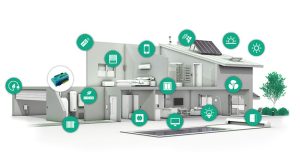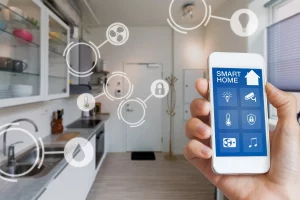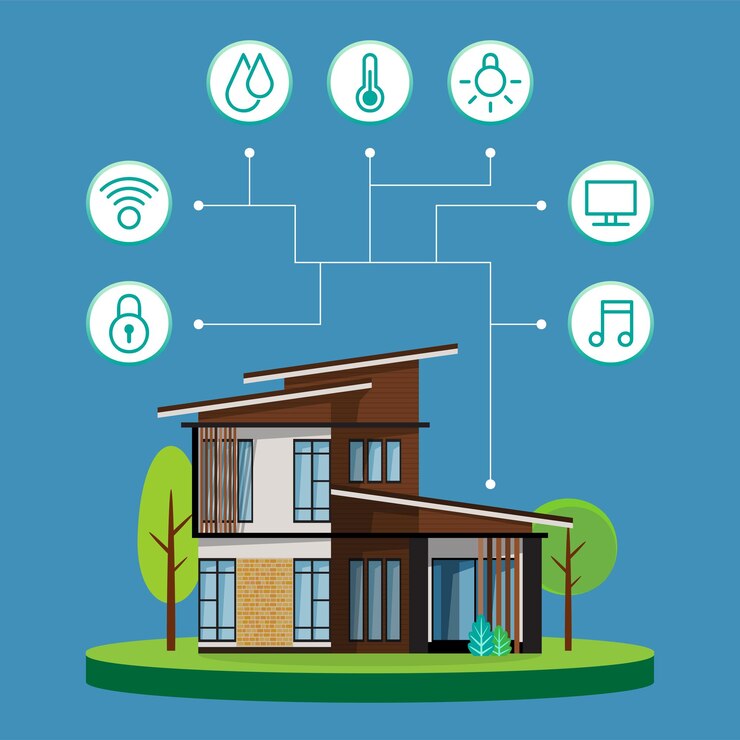The concept of a home that knows your preferences, anticipates your needs, and ensures your security is no longer futuristic—it’s a reality, thanks to the Internet of Things (IoT). This technology enables homes to become “smart,” offering enhanced convenience, energy efficiency, and security. In this article, we’ll explore how IoT is revolutionizing smart homes, the key applications, the benefits, the challenges, and the exciting future of IoT in smart living. We’ll also include a comparative analysis to help you understand how IoT impacts various aspects of home living.
The Rise of IoT in Smart Homes

IoT smart homes are equipped with interconnected devices that use sensors, automation, and data to improve daily living. From smart TVs to energy-efficient devices, IoT transforms how we interact with our homes, turning them into a seamless, personalized environment that enhances comfort, safety, and energy efficiency.
Key Applications of IoT in Smart Homes
1. Home Automation
Home automation is the most common application of IoT in smart homes. Devices like smart lighting, thermostats, and appliances can be controlled via smartphones or even voice assistants like Amazon Echo and Google Home. These devices enable homeowners to automate daily tasks such as adjusting temperatures, switching lights on and off, and managing home appliances remotely.
2. Security Systems
IoT has revolutionized home security with devices such as security cameras, smart locks, and motion detectors. These tools provide real-time surveillance, sending notifications to your phone when suspicious activity is detected. Home security systems can be integrated with broader smart city initiatives, allowing for enhanced community safety measures.
3. Energy-Efficient Devices
Smart thermostats, lights, and appliances are designed to reduce energy consumption. These energy-efficient devices can learn from user behaviors to optimize energy use. For example, smart lighting systems turn off when no one is in the room, and smart thermostats adjust based on your routine.
4. Entertainment Systems
With IoT, entertainment is just a voice command away. Smart TVs and audio systems can be synced to a central hub, allowing you to control your entertainment from your smartphone or through voice commands. These systems are part of a growing trend towards fully integrated IoT smart homes.
5. Health and Well-Being
Health-related IoT devices are also making their way into homes, especially in the form of remote health monitoring, medication reminders, and telemedicine. For elderly residents, these devices provide peace of mind, helping them manage their health without needing frequent doctor visits.
6. Home Maintenance

IoT sensors monitor home systems like HVAC, plumbing, and electrical grids, alerting homeowners to potential maintenance issues before they become costly repairs. These sensors can even order parts or schedule repairs automatically, streamlining the maintenance process.
7. Voice Assistants
Voice assistants such as Amazon’s Alexa and Google Assistant act as the central command hub for various IoT devices. They make homes more interactive, allowing homeowners to control various functions through simple voice commands, creating a smoother user experience.
Benefits of IoT in Smart Homes
1. Convenience
IoT smart homes make daily tasks more convenient. You can control everything from the lighting to the thermostat remotely or through voice commands, making life more streamlined.
2. Enhanced Security
IoT-based security systems ensure real-time surveillance and instant notifications, providing homeowners peace of mind. With smart doorbells, cameras, and motion sensors, securing your home is easier than ever.
3. Energy Efficiency
Energy efficiency is one of the standout features of IoT in smart homes. Energy-efficient devices help homeowners reduce their environmental footprint while lowering energy bills.
4. Personalization
IoT smart homes can learn user preferences, making the home environment adaptable to individual needs. From adjusting room temperatures to playing your favorite music, the system tailors itself to your lifestyle.
5. Accessibility
For individuals with disabilities, smart homes offer accessibility features that make daily living easier. Voice commands, automated devices, and smart home ecosystems provide an enhanced quality of life.
Challenges of IoT in Smart Homes
1. Data Security and Privacy
The massive amounts of data collected by IoT devices raise concerns about privacy and data security. Cybersecurity measures must be in place to protect sensitive information from potential breaches.
2. Interoperability
One of the main challenges for IoT smart homes is ensuring that all devices communicate seamlessly. A lack of standardized protocols across manufacturers can create compatibility issues.
3. Cost of Implementation
The initial investment required for IoT smart home systems can be high. However, the long-term savings in energy costs and convenience may offset the upfront expenses.
4. Reliability
IoT devices must be reliable to maintain user trust. Any downtime or malfunction in devices could result in security risks or inconvenient disruptions.
5. Workforce Training
The adoption of IoT technologies often requires workforce training for efficient operation. Households may need time to adapt to new technologies and learn how to use them effectively.
Future Trends in IoT Smart Homes

The future of IoT in smart homes is exciting and full of potential. Here are some trends to watch for:
1. Artificial Intelligence (AI) Integration
AI will play a significant role in smart homes, making automation even smarter. AI will enable homes to anticipate needs and act autonomously, making daily routines even more efficient.
2. Enhanced Security
Security systems will become more sophisticated, with AI and machine learning detecting potential security breaches before they happen.
3. Sustainability
IoT in smart homes will continue to prioritize energy efficiency, contributing to broader sustainability goals. Homes will increasingly be designed to minimize energy use, integrate with renewable energy sources, and reduce waste.
4. Integration with Smart Cities
As smart cities grow, IoT smart homes will integrate seamlessly with urban infrastructure. Smart city initiatives aim to improve not only individual homes but entire neighborhoods through better resource management and public safety.
Comparative Analysis of IoT Applications in Smart Homes
| Feature | Traditional Homes | IoT Smart Homes |
|---|---|---|
| Energy Efficiency | Limited to manual settings | Automated energy-efficient devices |
| Security | Basic security measures | Smart security cameras and locks |
| Entertainment | Standalone devices | Integrated, voice-controlled systems |
| Maintenance | Reactive, costly repairs | Proactive, sensor-based maintenance |
| Convenience | Manual operation of devices | Remote and automated control |
| Data Security | No concerns | Potential data privacy risks |
Analysis: IoT Smart Homes and Smart City Initiatives
| Smart City Initiative | IoT Application | Benefit |
|---|---|---|
| Energy Efficiency | Smart grids, energy-efficient devices | Reduces energy consumption, lowers costs |
| Security | Integrated home and city security systems | Enhances overall public safety |
| Sustainability | Waste and water management | Minimizes resource wastage, promotes sustainability |
| Transportation | IoT-enabled traffic monitoring | Reduces congestion, improves mobility |
Conclusion
The Internet of Things has ushered in a new era of smart homes, transforming the way we live, work, and interact with our environments. From energy-efficient devices and enhanced security systems to personalized living experiences, IoT in smart homes is reshaping modern living. While challenges such as data security and high costs exist, the benefits far outweigh the drawbacks. As technology advances and integrates further with smart cities, IoT will continue to enhance not just individual homes but urban living as a whole.




